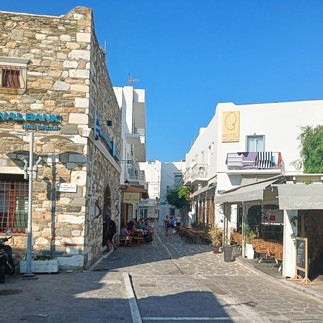Exploring the Greek Islands – My Personal Take on the Ones I’ve Visited (Part I)
- Sea4Soul

- Jul 7
- 8 min read
Because of my business in Greece and my deep love for the sea, I find myself visiting this beloved country several times a year. Over time, I’ve had the chance to explore many of its islands — and occasionally share those stories on my personal blog.
But I keep getting the same question: "Which island should I visit?"
So I decided to write a dedicated post summing up everything I’ve learned about the Greek islands over the years. I promise to keep updating it as I discover more gems — starting with a few lesser-known favorites.
Trizonia – A Hidden Jewel in the Corinthian Gulf
I stumbled upon Trizonia completely by chance. It wasn’t in our sailing plan — or any plan at all.
We were on a delivery trip, sailing from Rhodes to Corfu. After crossing the Corinth Canal, we were hoping to push westward toward the Ionian Sea. But the weather had other ideas. That day brought strong winds and rough seas, so we decided to look for a safe place to anchor for the night. A quick search on Navily revealed a small island I had never heard of — with a brand-new marina.
We headed straight there.
Trizonia is a tiny, green island located on the northern shores of the Corinthian Gulf, just below Delphi and only 300 meters from the mainland, across from the villages of Chania and Glyfada. At just 2.5 km² with around 64 permanent residents, the island is dotted with cozy guesthouses, small family-run hotels, and a few lovely tavernas — all at very affordable prices.
Expect small, beautiful beaches, untouched coves, and a picturesque little fishing marina.
This is a place for rest, romance, and total relaxation.
Vibe: Laid-back, romantic, peaceful
Nightlife: Taverns, cafés, and a few low-key bars
Getting there: Best reached by car. There may be buses to Glyfada, but I recommend driving.
Ideal for: Couples, older travelers, and anyone seeking a quiet getaway. Also great as a base for visiting Delphi, Messolonghi, and Patras — or for catching a ferry to Kefalonia or Lefkada
Poros – My Personal Favorite
So far, Poros might just be my favorite island in Greece. It offers everything I personally look for in a vacation: tranquility, raw natural beauty, breathtaking bays, organized beaches, proximity to a major city, and easy sea access.
While it’s dotted with tavernas and charming cafés, it doesn’t have a wild nightlife scene, making it less attractive to the party crowd — and more appealing to travelers like me.
Poros sits in the Saronic Gulf, just 600 meters off the Peloponnesian coast, and consists of two islands (Kalavria and Sferia) connected by a small bridge. Together, they form what everyone simply calls "Poros."
The island’s main village, also named Poros, rests on a hillside facing the Peloponnese and the town of Galatas. You’ll find scenic walking trails, some of them urban, with spectacular views along the way.
For a bit of adventure, rent an ATV and explore the secluded eastern coves. Then head back to town in the evening to soak up the relaxed local vibe.
Vibe: Elegant, peaceful, authentic
Nightlife: Taverns, cafés, a few bars
Getting there: One hour and fifteen minutes by ferry from Piraeus, or drive to Galatas and take a 5-minute ferry across. There’s also a direct bus from Athens.Ideal for: Adults, couples, and nature lovers looking for a quiet yet accessible escape.
Aegina – Nature, Simplicity, and Local Charm
Aegina is one of the larger islands in the Saronic Gulf — just 10 km at its widest and longest points — and it’s located very close to Athens. Many of its residents actually commute to the capital for work.
It’s the perfect island for nature lovers who appreciate authentic villages and a slower pace of life. While I haven’t explored every corner of the island yet, I can wholeheartedly recommend a visit to two places:
Aegina Town: The largest and liveliest village on the island, full of charming alleys, local markets, fishing boats, and lovely beaches.
Perdika: A quaint, colorful seaside village on the southwest coast, filled with friendly locals and great tavernas. From there, hop on a boat to the nearby uninhabited island of Moni — a stunning spot for sunbathing and swimming.
Vibe: Laid-back, rustic, and very localNightlife: Taverns, cafés, some beach barsGetting there: Less than an hour by ferry from PiraeusIdeal for: Nature lovers, couples, and travelers who want a quick and easy island getaway from Athens.
Methana Peninsula – For the Adventurous Spirit
If you’re into nature and authenticity, Methana should be high on your list.
Technically a peninsula connected by a narrow strip to the Peloponnese, Methana was formed by volcanic activity and features a hikeable volcano — a must for outdoor enthusiasts.
This is the least touristy of the Saronic islands, which is why there’s only one ferry per day. But trust me — the dramatic landscapes and small, untouched villages are absolutely worth the effort.
You’ll also find natural hot sulfur springs, some bubbling right at the water’s edge — all completely free. Imagine switching from cold sea water to a hot, mineral-rich spring within seconds.
Don’t miss the shallow lagoon between Methana and the mainland — and yes, there are some beaches where you can go au naturel without raising an eyebrow (no, this isn’t a formal recommendation!).
There are a few small hotels and guesthouses, but don’t expect luxury. If you're into hiking and raw beauty, this is your place.
Vibe: Rugged, natural, off-the-beaten-path
Nightlife: Taverns and low-key cafés
Getting there: Around 2.5 hours by car from Athens or less than an hour by ferry from Piraeus
Ideal for: Nature lovers, peace seekers, and travelers craving authenticity.
Hydra – Beauty, History, and Timeless Charm
Although technically outside the Saronic Gulf, Hydra is considered part of the Saronic Islands and is one of Greece’s most iconic and photogenic destinations. It’s especially popular among American travelers — thanks in part to Leonard Cohen, who lived here for several years and wrote some of his most famous songs on the island.
In the 18th and 19th centuries, Hydra was a hub of maritime trade, home to wealthy merchants who built magnificent stone mansions overlooking the harbor. These houses — inspired by Italian maritime cities like Venice and Genoa — still surround the port today.
The island's prosperity stemmed from operating on the fine line between legitimate trade, smuggling, and piracy. The easily fortified harbor allowed residents to maintain a semi-independent life under Ottoman rule. Cannons still face out to sea from the harbor walls, a reminder of those rebellious days.
Hydra spans 50 km², and there are no cars — just donkeys, mules, and a few maintenance vehicles. The main (and nearly only) village, Hydra Town, clings to a steep hillside on the island’s north side, about 4 km from the Peloponnesian coast.
It’s one of the most uniquely beautiful islands in Greece and well worth at least one visit — even if, in my opinion, it’s become a bit too touristy and expensive. Many visitors come just for a few hours on day trips from the Peloponnese.
You’ll find excellent restaurants, but nightlife is limited.
Vibe: Sophisticated, romantic, and historic
Nightlife: High-quality dining and café culture
Getting there: Only by ferry — from Piraeus or from nearby Spetses. Travelers in the Peloponnese can also take small boats from Metochi.
Ideal for: Lovers of beauty, art, and peace — and those looking to explore a destination rich with history and charm.
Pelion Peninsula – Greece’s Best-Kept Secret
I could easily write an entire book about Pelion — and maybe one day I will. But for now, let me just say this: it has everything.
If you're into nature, hiking, villages, hidden coves, or even beach parties — Pelion delivers. I highly recommend spending at least four days here (though a week would be ideal).
Pelion is shaped like a boot and located in northern Greece, just south of Thessaloniki and the Halkidiki peninsula. You can think of it in four distinct sections:
Volos – The bustling port city at the northern tip of the peninsula, where you’ll find everything you need. During the season, direct flights from Israel are available.
The Western Coast – Facing the Pagasetic Gulf, this area feels like Thailand: turquoise waters, untouched bays, and charming villages perfect for day trips, swimming, and water sports.
The Eastern Coast – Wild and dramatic, with rugged Aegean beaches that evoke the landscapes of Ireland or Scotland. Many beaches, such as Milopotamos, Damouchari, and Fakistra, require a short hike down the cliffs — but the reward is stunning, secluded beauty.
The Mountain Ridge – Towering between the two coasts, this alpine-like ridge reaches heights of 1,750 meters and even has a small ski resort in winter. It divides the peninsula and offers crisp mountain air and spectacular scenery.
Pelion is crisscrossed by streams, waterfalls, and hiking trails that link coast to coast and climb deep into the mountains. The character of the villages shifts between mountain charm and coastal calm — and the diversity is part of the magic.
If you visit Pelion for a week during the season, you’ll get it all: hikes, beaches, nature, great food, lively towns, and even the occasional party.
Vibe: Diverse and rich — ideal for everyone
Nightlife: Varies by location — from serene to festive
Getting there: Car only (a must to explore)
Paros – Cycladic Energy and Party Spirit
Let’s clear this up first: Paros and Poros are two very different islands in very different parts of Greece.
While Poros belongs to the Saronic Islands near Athens, Paros is part of the Cyclades — that iconic island group scattered in the southern Aegean between Crete and mainland Greece.
The Cycladic islands are best visited during the season (June to September). Outside these months, the weather turns unpredictable and many places simply shut down.
Due to their location, these islands are heavily affected by strong northern winds known as Meltemi. These winds — a unique phenomenon caused by the interplay of European air masses, Mediterranean heat, and mountainous terrain — can whip through the region, especially in July, August, and September.
The result? A raw and powerful landscape. Most of the Cycladic islands are dry and barren — except in spots sheltered from the wind. In Paros, as in many of its neighboring islands, you’ll find whitewashed villages with bright blue shutters, cobblestone alleys, and postcard-perfect views.
Paros attracts a mix of young travelers looking to party and others simply in search of sun and sea. The island is filled with accommodations ranging from luxury hotels to simple guesthouses, and the beaches and bays are absolutely stunning.
To be honest, it’s not really my kind of island — but if you're into beach vibes, good music, and long, lazy afternoons, you’ll probably love it.
Vibe: Lively, summery, carefree
Nightlife: Vibrant — from beach bars to nightclubs, depending on the areaGetting there: 4-hour ferry from Athens or a short domestic flight (book early!)
Ideal for: Young travelers, beach lovers, partygoers
Tucked away on Greece’s western coast, Lefkada is a peaceful, breathtaking island that offers something special for families, nature lovers, and those looking to unwind. You won’t find massive resorts or all-inclusive party hotels here — and that’s exactly the point.
While Lefkada Town does offer a bit of nightlife during high season, this island isn’t built for clubbers. It’s designed for explorers.
Rent a car and circle the island. Visit Vasiliki in the south, Vlicho, Nydri, and Desimi, stopping in bay after bay to swim, eat, and relax. You can even rent a small motorboat (no license required!) and chart your own adventure.
I recommend spending a couple of nights in Lefkada Town — it’s charming and lively, especially in season.
Just note that winters here can get chilly, but the island is still accessible year-round.
Vibe: Relaxed, authentic, and family-friendly
Nightlife: Cafés, bars, tavernas — plus some summer parties in town
Getting there:
Seasonal flights to nearby Preveza, followed by taxi or rental car
Or drive from Athens (around 3 hours)
Ferries also operate from PatrasIdeal for: Families, couples, hiking enthusiasts, and anyone who appreciates slow travel
More islands coming in the next chapter…
Stay tuned.


























































Comments